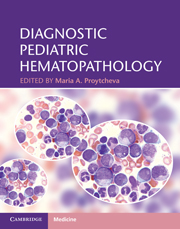Book contents
- Frontmatter
- Contents
- List of contributors
- Acknowledgements
- Introduction
- Section 1 General and non-neoplastic hematopathology
- 1 Hematologic values in the healthy fetus, neonate, and child
- 2 Normal bone marrow
- 3 Disorders of erythrocyte production
- 4 Disorders of hemoglobin synthesis
- 5 Hemolytic anemias
- 6 Inherited and acquired bone marrow failure syndromes associated with multiple cytopenias
- 7 Inherited bone marrow failure syndromes and acquired disorders associated with single peripheral blood cytopenia
- 8 Peripheral blood and bone marrow manifestations of metabolic storage diseases
- 9 Reactive lymphadenopathies
- Section 2 Neoplastic hematopathology
- Index
- References
3 - Disorders of erythrocyte production
Nutritional deficiencies, iron deficient, and sideroblastic anemia
from Section 1 - General and non-neoplastic hematopathology
Published online by Cambridge University Press: 03 May 2011
- Frontmatter
- Contents
- List of contributors
- Acknowledgements
- Introduction
- Section 1 General and non-neoplastic hematopathology
- 1 Hematologic values in the healthy fetus, neonate, and child
- 2 Normal bone marrow
- 3 Disorders of erythrocyte production
- 4 Disorders of hemoglobin synthesis
- 5 Hemolytic anemias
- 6 Inherited and acquired bone marrow failure syndromes associated with multiple cytopenias
- 7 Inherited bone marrow failure syndromes and acquired disorders associated with single peripheral blood cytopenia
- 8 Peripheral blood and bone marrow manifestations of metabolic storage diseases
- 9 Reactive lymphadenopathies
- Section 2 Neoplastic hematopathology
- Index
- References
Summary
Introduction
Defects in hemoglobin synthesis and erythroid nuclear maturation both give rise to disorders of erythrocyte production. Defects of hemoglobin synthesis can result from impaired heme synthesis, as seen in iron deficiency and sideroblastic anemia, or from impaired globin chain synthesis, which occurs in the thalassemia syndromes. Defects in erythroid nuclear maturation are seen in cobalamin (vitamin B12) and folate deficiency and also in the rare hereditary abnormalities of cobalamin or folate metabolism, and result in defective erythrocyte production. Abnormal nuclear maturation is also present in other metabolic defects associated with megaloblastic anemia, such as Lesch–Nyhan syndrome, orotic aciduria, and thiamine-responsive megaloblastic anemia. In the anemia of chronic disorder, iron regulation is maladjusted so that iron is “locked away” and unavailable for erythropoiesis. Markedly ineffective erythropoiesis is seen where there are defects of nuclear maturation, in sideroblastic anemia, and in the thalassemia syndromes; iron deficiency and the anemia of chronic disorder are associated with decreased erythropoiesis. Of the nutritional deficiencies causing anemia, the commonest is iron deficiency. This is so for both children and adults in all parts of the world. The deficiency may be caused by insufficient iron in the diet, lack of absorption of iron, or increased losses primarily due to bleeding. Deficiency of vitamin B12 is rare in children; in neonates it is usually secondary to occult vitamin B12 deficiency in the mother, but when diagnosed in infancy or childhood is more often due to an inborn error of metabolism.
- Type
- Chapter
- Information
- Diagnostic Pediatric Hematopathology , pp. 38 - 56Publisher: Cambridge University PressPrint publication year: 2011
References
- 1
- Cited by



